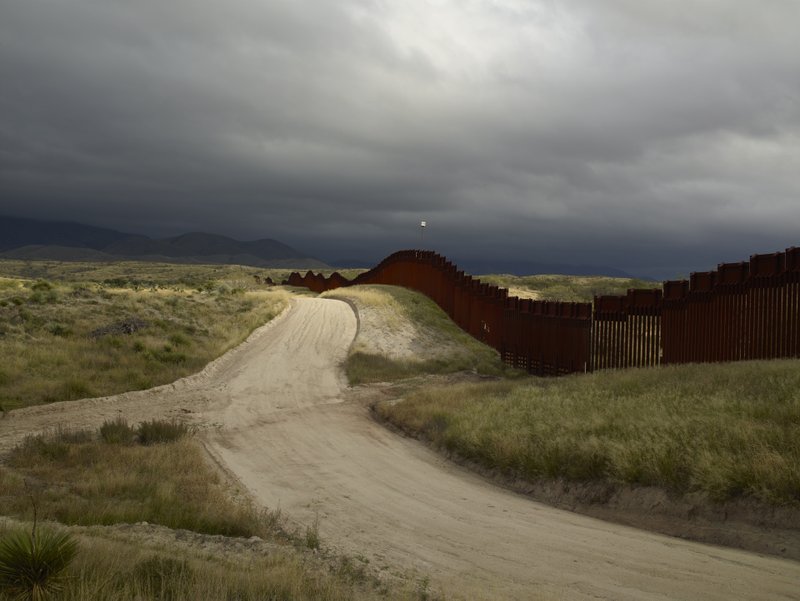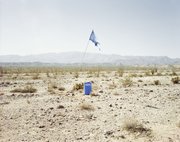When the staff at Crystal Bridges Museum of American Art in Bentonville were planning the temporary exhibitions schedule for 2017, they couldn't have known just how socially and politically relevant the first exhibition of the year would be. A collaboration between American photographer Richard Misrach and Mexican-American composer and artist Guillermo Galindo, "Border Cantos" uses large-scale photography and the sounds of instruments made from found objects to orient people with the abstract concept of "the border."
RELATED ARTICLE
http://www.arkansas…">Museum exhibit distills the Mexico-U.S. border
"It is eerily timely how this has come about [at this time], but we're really hoping that initiates an interest in people to come see it and maybe consider issues in a different way," says Ali Demorotski, Crystal Bridges' curatorial lead on the project. While art can often seem like a response to social anxieties of the time, Misrach has been photographing the border for more than a decade -- placing the project's inception ahead of the heightened unrest regarding the Mexico-American border of the past year and a half. "It's very complicated; there's no cut-and-dry, easy answer. But maybe in seeing [the exhibition] and considering it, people can kind of grapple with their feelings and their thoughts on the larger issue, because it's not just our southern border -- it's a global phenomenon that happens constantly."
One of Crystal Bridges' objectives is to explore stories of the American experience from diverse backgrounds with its temporary exhibitions, as in its permanent collection. Recognizing the role immigration has played in shaping the human capital of Northwest Arkansas, the curatorial team worked with a team of people -- including an interpretation manager, education partners and an advisory committee of Hispanic and Latino community leaders -- to ensure the audience can engage and connect with the material in the most effective ways. Blending voices from the actual community in which the exhibition is on display with the more formal "museum voice" is another way to bridge the boundaries between people as well as the boundaries between the art and understanding.
"One of the things we heard from the focus groups was that they wanted to see some of the hopeful side of the journey because that's usually why people are risking the move -- they're hoping there will be a better outcome for them," Demorotski says.
Despite the exhibition digging into the topic of migration and illegal immigration at the Mexico border, there is a distinct lack of faces and individual imagery in much of the work. The images instead offer views of sweeping landscapes, representations of life on the American side of the border or a look at objects left behind by both travelers and the border patrol. Demorotski suggests the absence of human form in the depictions might offer viewers more room for personal interpretation about the people who were once here and their experiences, rather than being so directly confronted with explicit views from any one perspective.
"We're artists; we're not politicians. We want to give people the experience of the border and to get acquainted with the immigrants' journey. To make it palpable. To make it human," Galindo says of the collaboration.
"There is an emotional reaction that people have, and it can range from sadness to hurt to anger," Demorotski offers. "The lack of human presence in a physical sense is not what is driving that. It's looking at the objects that have been left behind and thinking that somebody packed those objects and left home, potentially with the intention of never going back again. Or [it's] looking at these landscapes and thinking what would it be like to walk for miles on end and not know where you'll be at the end of the day."
The voices of the migrants communicate with the viewer through the instrumental sculptures comprising belongings they left behind -- a toothbrush, food tins, children's clothing. While the drag tires, spent shotgun shells and sections of the wall itself tell another story. Although the sculptures in the exhibition will be static, they have all been used as an instrument in the past and recorded audio or video of Galindo playing them will accompany some of the pieces. Guests will also have several opportunities to attend performances where Galindo will activate some of his creations during his time in Northwest Arkansas.
"There's a Mesoamerican belief that objects carry the voice of their past and so [Galindo] does not believe he's creating that sound from these objects, he believes he's releasing the sound and the past -- who had owned it and how it had been left," Demorotski says. "It's not classically beautiful music -- beautiful in the traditional term of how we consider music -- so I think [the sounds are] going to challenge the idea of how we're interpreting sound and space by using the found objects instead of traditional instruments."
"Border Cantos: Sight & Sound Explorations from the Mexican-American Border" will be presented in English and Spanish -- including all gallery text displayed in both languages for the first time -- and the museum will offer tours in Spanish on Sundays. Jivette de Hesus, a member of the advisory committee, says the exhibition fosters a sense of belonging among the Hispanic commnunity by sending the message that they are just as much a part of the Northwest Arkansas community as everyone else.
"It makes it real. It makes the border real," de Hesus says. She adds she hopes "Border Cantos" will help people see the "barriers immigrants have overcome -- real or imagined -- and they are beautiful, successful people who want to help the community."
"I feel like 'the wall' has become such a soundbite that I hope people give [the exhibit] the chance, and don't already assume they know what that's like," Demorotski shares. "I think no matter what you believe, there's something to learn here, and I hope it really gets our community more involved or open to conversation about [how immigration] has helped build who we are."
NAN What's Up on 02/17/2017


